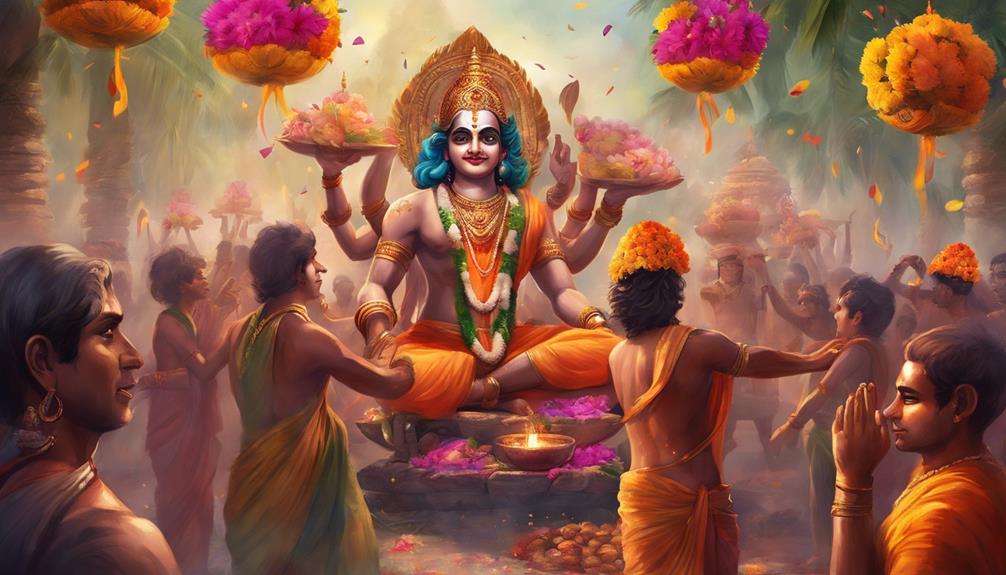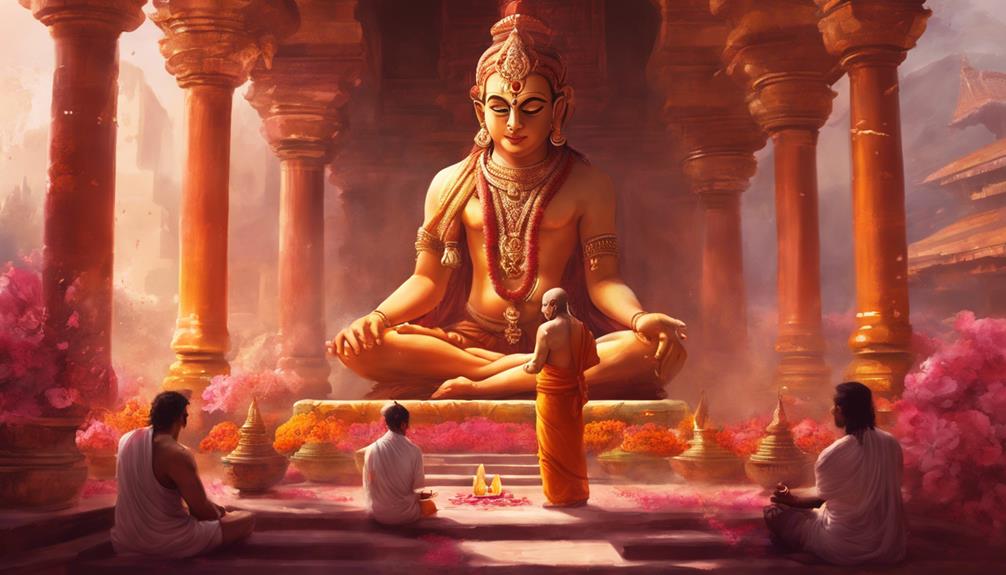Explore the worship of Lord Kartikeya, the venerated deity in Hinduism known for embodying bravery, wisdom, and righteousness. His significance lies in his divine origins as the son of Lord Shiva and Goddess Parvati, depicted in mythological tales as a vanquisher of demons. Through symbolism like his vel (spear) representing his warrior nature and the peacock symbolizing his ability to conquer ego, devotees connect with his profound attributes. By investigating temples, pilgrimage sites, and participating in elaborate rituals and festivals, you can unravel the rich cultural heritage and spiritual devotion associated with Lord Kartikeya.
Table of Contents
Key Takeaways
- Worshipped through sacred rituals, mantras, and prayers for blessings.
- Symbolizes bravery, wisdom, and righteousness in Hindu mythology.
- Depicted with iconic symbols like the vel, peacock, and tilak.
- Revered in temples and pilgrimage sites for spiritual connection.
- Festivals, processions, and rituals celebrate his divine significance.
Origins and Mythological Stories
Originating from ancient Hindu mythology, the tales surrounding Lord Kartikeya provide insight into his significance and divine attributes. Known as the son of Lord Shiva and Goddess Parvati, Kartikeya is a revered deity in Hinduism, embodying qualities of bravery, wisdom, and righteousness. Mythological tales depict his divine origins, including his role in vanquishing demons and protecting devotees from evil forces. These stories not only highlight his extraordinary powers but also serve as moral lessons for followers on the importance of courage and determination in the face of adversity.
In Hindu devotional practices, Lord Kartikeya holds a special place, with devotees offering prayers and performing rituals to seek his blessings for success, prosperity, and protection. His cultural significance extends beyond religious domains, with festivals like Skanda Shasti celebrated in his honor, showcasing the deep-rooted reverence for this deity in Hindu society. Understanding the mythological narratives and divine origins of Lord Kartikeya is essential in comprehending his symbolic importance and enduring influence in Hindu spirituality.
Symbolism and Iconography
As you explore the worship and significance of Lord Kartikeya, delving into the domain of symbolism and iconography reveals a rich tapestry of symbolic attributes and iconic representations associated with this deity.
Understanding the deeper layers of Lord Kartikeya's symbolism and iconography sheds light on the multifaceted aspects of his divine persona and significance in Hindu mythology.
Symbolic Attributes
What symbolic attributes are associated with Lord Kartikeya regarding symbolism and iconography?
Lord Kartikeya, also known as Murugan, is often depicted holding a vel (spear) in one hand, symbolizing his warrior nature and his power to overcome obstacles.
The peacock, his vahana (vehicle), represents his ability to conquer ego and maintain a majestic presence.
Lord Kartikeya is adorned with a tilak on his forehead, signifying his wisdom and divine knowledge.
His six faces symbolize the ability to see in all directions and remain omniscient.
The symbolism associated with Lord Kartikeya's attributes plays an important role in understanding his symbolic significance and is often incorporated into worship practices to invoke his blessings and guidance.
Iconic Representations
In the depiction of Lord Kartikeya through symbolism and iconography, his attributes serve as powerful visual representations of his divine nature and significance. Iconic depictions of Lord Kartikeya often feature him riding a peacock, holding a spear or Vel in one hand, symbolizing his warrior nature and ability to overcome obstacles.
The peacock symbolizes beauty, fertility, and wisdom, emphasizing Lord Kartikeya's role as a deity associated with valor and protection. Additionally, artistic interpretations frequently depict him with six faces, representing his mastery over the five senses and the mind.
These intricate details in Lord Kartikeya's iconic representations not only showcase his multifaceted character but also provide devotees with a visual language to connect with his divine essence.
Temples and Pilgrimage Sites

When exploring the temples and pilgrimage sites dedicated to Lord Kartikeya, one can observe the intricate sacred rituals performed within the sanctuaries. These rituals hold historical significance, often dating back centuries, reflecting the deep-rooted traditions and beliefs of devotees.
Pilgrims often recount profound spiritual experiences during their visits to these sacred sites, fostering a strong connection to the divine.
Sacred Temple Rituals
Exploring the sacred temple rituals associated with Lord Kartikeya reveals the intricate tapestry of customs and practices intertwined with pilgrimage sites dedicated to the deity.
Temple traditions surrounding Lord Kartikeya often involve elaborate ceremonies conducted by priests and devotees. These rituals, deeply rooted in tradition, aim to honor the divine essence of Kartikeya and seek his blessings for protection and prosperity.
Devotees participate in offerings such as flowers, fruits, incense, and prayers as a way to show reverence and seek divine intervention. The atmosphere within these temples is charged with spiritual energy, creating a sense of sanctity and devotion among the worshippers.
Through these sacred temple rituals, devotees connect with the spiritual domain and express their faith in Lord Kartikeya's grace and guidance.
Historical Pilgrimage Significance
The historical pilgrimage importance of Lord Kartikeya's temples and pilgrimage sites reveals a rich tapestry of cultural heritage and spiritual devotion intertwined with the deity's worship. Throughout history, pilgrimage sites dedicated to Lord Kartikeya have served as focal points for devotees seeking spiritual solace and divine blessings.
Temples such as the Six Abodes of Murugan in Tamil Nadu, India, and the sacred shrines atop Mount Arunachala in Thiruvannamalai have drawn devotees from far and wide due to their historical significance. These pilgrimage sites not only symbolize the deep-rooted reverence for Lord Kartikeya but also embody the architectural and religious traditions that have been passed down through generations.
Visiting these sacred places allows devotees to immerse themselves in the historical and spiritual legacy of Lord Kartikeya's worship.
Devotees Spiritual Experiences
Devotees' encounters at temples and pilgrimage sites offer profound spiritual insights and connections beyond the physical domain. Through personal encounters with Lord Kartikeya's divine presence in these sacred spaces, individuals often undergo inner transformation and experience significant spiritual growth.
Many devotees report feeling a deep sense of peace and clarity during their visit, as if their burdens have been lifted and their minds calmed. The energy and vibrations within these spiritual sites are believed to facilitate a heightened state of consciousness, allowing worshippers to connect with the divine on a profound level.
Such experiences often leave a lasting impact on individuals, inspiring them to continue their spiritual journey with renewed fervor and dedication.
Festivals and Celebrations

During the festivals and celebrations dedicated to Lord Kartikeya, devotees partake in elaborate rituals and processions to honor his divine presence. Ritual dances and musical offerings fill the air with a sense of spiritual fervor and devotion. Decorative processions wind their way through the streets, showcasing the grandeur and magnificence associated with Lord Kartikeya. Elaborate ceremonies are conducted in temples and sacred sites, symbolizing the cosmic significance of the deity and the eternal battle against evil forces.
The festivals serve as a time of communal rejoicing and spiritual renewal, fostering a sense of unity among the devotees. Through their active participation in these celebrations, devotees express their reverence and gratitude towards Lord Kartikeya, seeking his blessings for protection, courage, and wisdom. The vibrant colors, enchanting music, and the rhythmic movements during these festivities create an atmosphere of joy and devotion, allowing the worshippers to connect with the divine presence of Lord Kartikeya on a profound level.
Mantras and Prayers
Participating in the worship of Lord Kartikeya involves the recitation of powerful mantras and heartfelt prayers to seek his divine blessings and guidance. Ritual practices associated with Lord Kartikeya often include chanting mantras specific to him, such as the 'Om Saravanabhavaya Namah' mantra, which is believed to invoke his energy and protection. Chanting mantras is a form of meditation that helps devotees focus their minds and connect with the spiritual domain where Lord Kartikeya resides.
Offering prayers is another essential aspect of worshipping Lord Kartikeya. Devotees express their devotion, gratitude, and requests through sincere prayers, seeking his blessings for strength, courage, and wisdom. The act of prayer is deeply ingrained in the worship of Lord Kartikeya, as it allows individuals to establish a personal connection with him and seek his divine intervention in various aspects of their lives.
Incorporating these ritual practices, meditation techniques, chanting mantras, and offering prayers are fundamental ways through which devotees engage in the worship of Lord Kartikeya, seeking his divine presence and guidance in their spiritual journey.
Modern Practices and Devotion

In contemporary worship practices focused on Lord Kartikeya, a shift towards incorporating technology and online platforms can be observed, reflecting the adaptability of devotion to modern lifestyles. Modern practices of devotion to Lord Kartikeya often involve virtual offerings, online pujas, and live-streamed ceremonies. Devotees engage in virtual darshans, where they can connect with the deity through live video feeds from temples or participate in online satsangs and discussions about Lord Kartikeya's significance.
Contemporary devotion to Lord Kartikeya also encompasses the use of social media platforms to create virtual communities of devotees who share their experiences, prayers, and knowledge about the deity. Online forums and groups provide spaces for devotees to seek guidance, share devotional songs and stories, and participate in virtual rituals together.
Furthermore, modern practices include the use of mobile applications that offer daily prayers, mantras, and teachings related to Lord Kartikeya, allowing devotees to integrate worship into their daily routines conveniently. The marriage of technology and devotion demonstrates the enduring relevance of Lord Kartikeya in contemporary times and highlights the evolving nature of religious practices in the digital age.
Frequently Asked Questions
What Are Some Common Offerings Made to Lord Kartikeya During Worship?
When worshipping Lord Kartikeya, devotees commonly offer fruits, flowers, sweets, and incense as symbolic gestures of devotion. These ritual practices hold deep spiritual significance, fostering a connection with the deity and seeking his blessings.
Are There Any Specific Rituals or Customs Associated With Worshipping Lord Kartikeya That Devotees Should Follow?
When worshipping Lord Kartikeya, it is essential to follow specific rituals and customs that hold great importance. Devotees engage in devotional practices and celebrate festivals in honor of Kartikeya, enriching their spiritual connection with the deity.
How Is Lord Kartikeya's Worship Different From Other Hindu Gods and Goddesses?
When worshiping Lord Kartikeya, the focus shifts to ritualistic practices and devotional hymns. Different from other deities, his worship involves unique symbolic gestures that hold deep spiritual significance, creating a distinct devotional experience.
Are There Any Specific Days or Timings Considered Auspicious for Worshipping Lord Kartikeya?
For worshipping Lord Kartikeya, specific days like Skanda Sashti and timings like Tuesdays are auspicious. Rituals during festivals, customs during sacred timings, play essential roles in honoring this deity. Observing these enhances devotion and blessings.
What Are Some Lesser-Known Stories or Anecdotes About Lord Kartikeya That Are Not Commonly Known?
Discover lesser-known mythological tales and mystical experiences surrounding Lord Kartikeya. Explore the symbolism and iconography that unveil deeper layers of his significance. Unearth hidden anecdotes that enrich your understanding of this divine deity.
Conclusion
To sum up, Lord Kartikeya holds a significant role in Hindu mythology and is worshipped by millions of devotees around the world. His symbolism, iconography, temples, and festivals all contribute to the rich tapestry of Hindu culture and spirituality.
Through the recitation of mantras, prayers, and acts of devotion, followers continue to honor and seek blessings from this powerful deity. Lord Kartikeya remains a revered figure in the hearts and minds of his devotees, inspiring faith and devotion.